Having a sick pig can be stressful and traumatic, especially when trying to find the cause of its symptoms.
When my pig started vomiting uncontrollably, I knew that this was an acute symptom. Pigs can’t tell us when they feel sick or under the weather. Luckily, I contacted a neighboring pig farmer who had been in the pig-raising game for decades.
Pigs can develop illnesses and diseases like diamond skin, swine flu, and bacterial infections. If not treated quickly, illness can cause your pig to die suddenly.
How do you care for a sick pig? When a pig is sick, identify acute symptoms. Acute symptoms include vomiting, lethargy, lack of appetite, continuous diarrhea, constipation, body trembling, erratic twitching, and paralysis. Once you identify the symptoms, you can identify what’s wrong and know specific steps to take (listed below).
I had done all my research on creating a hygienic pigsty and what foods to avoid to prevent my pigs from getting sick. Generally, pigs are pretty easy to raise if they have good hygiene and a clean shelter with wholesome, nutritious food. However, they can still develop various illnesses and diseases, so you need to be hands-on with caring for your sick pigs.
Treating Multiple Symptoms: Vomiting, Diarrhea, Coughing…
If your pig only has one symptom, such as walking on its knees, it’s easier to identify and treat. That’s why I’ve put together a chart that identifies which combination of symptoms indicates which illness.
Diseases can have multiple symptoms, and while I learned about the 10 most common symptoms, your pig may have more than one sign they are sick. When you need to distinguish between Classical Swine Fever (CSF) and Gastroenteritis (TGE), paying attention to the combination of symptoms will steer you towards a correct diagnosis.
However, if you are ever uncertain about your pig’s disease, you should first consult with your vet as misdiagnosis can cause your pig to suffer and die.
What does a sick pig look like?
A sick pig lacks energy and isn’t eager to move around. Their skin color can be pale, red and splotchy, or turn a bluish shade. Their eyes may ooze a discharge or droop slightly and runny tummy or vomiting can occur.
Sick pigs become depressed and develop dry and cracked snouts, and they can cough and sneeze continuously or have a nasal discharge.
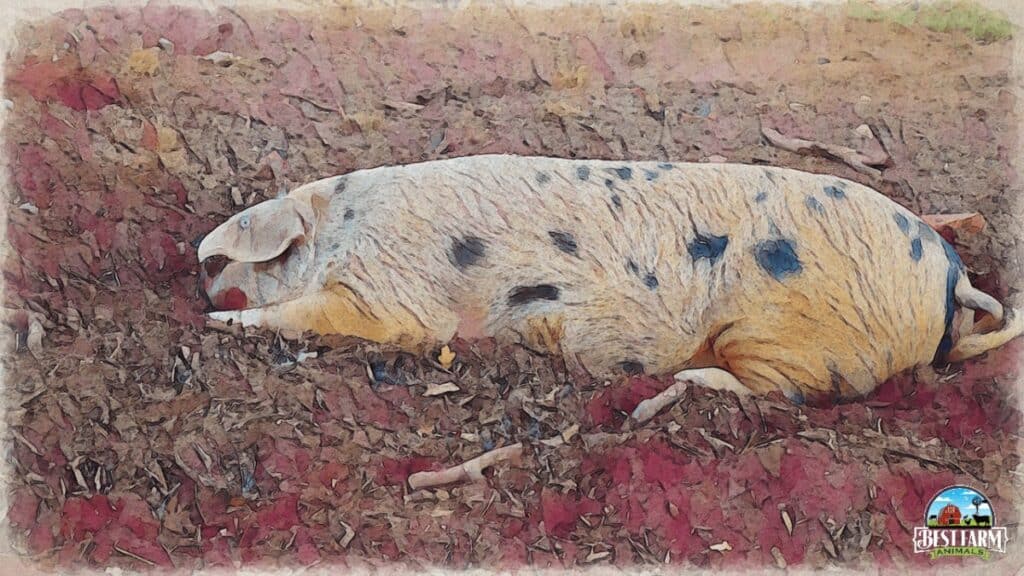
11 Sick Pig Symptoms and the Steps to Take
The first thing my new farmer friend asked me was what symptoms my pig was showing. As I ran through the list, he pointed out the critical signs. He warned me that missing any critical symptoms (especially if they are not caught early enough) could result in the death of my pig.
The illness can spread to your other pigs in the herd if you don’t catch it in time and take the necessary steps to treat the disease or condition. Paying attention to your pig when they are healthy will alert you when something is off.
What should a healthy pig look like? A healthy pig should move around, have bright eyes, and eat a good amount of food. Healthy pigs look alert and take regular mud baths. They should be no discharge or mucus from its eyes or nose. A healthy pig’s temperature should be between 101.5 and 102 degrees Fahrenheit.
Now that we know what the expected behavior of a healthy pig should be, let’s take a closer look at the 10 critical symptoms of a sick pig, as well as the steps you should take to treat them:
1. Pig Not Eating And Vomiting is Dangerous to Its Health
Keep a close eye on your pig if it starts to vomit so you can determine what’s causing it. As soon as symptoms start to show, isolate sick pigs. By doing so, you can stop the disease from spreading and learn which symptoms are specific to that pig.
Next, determine whether you’ve altered your pig’s diet, or if your pig has gotten into something it isn’t supposed to eat. If your pig eats too quickly, it could vomit even if it isn’t sick.
Review your deworming records for the most recent treatment because parasites can make pigs vomit.
Keep an eye out for any physical discomfort, pain, or cramping in your pig. Lastly, make sure your pig is passing stool by keeping an eye on its feces. Determine whether it is runny or hard. You will be better able to pinpoint the issue as a result.
Steps to Take if Your Pig Vomits Excessively:
Follow these steps when your pig presents with excessive vomiting:
- Don’t feed your pig food or water for at least 6 hours. If your pig is less than 10 pounds, you can rub sugar water on their gums every hour to prevent their blood sugar levels from dropping.
- If they don’t vomit for 6 hours, offer a small amount of water (no more than ¼ cup). If your pig refuses to drink, it might be nauseous. You should call the vet. However, if your pig drinks the water and doesn’t vomit, offer ½ cup every hour for the next 6 hours. With no further vomiting, they can drink water as usual. Continue monitoring them for the next 24 hours, but withhold pelleted feed.
- If your pig has doesn’t vomit 1 hour after drinking water, offer a small soft meal of soaked pellets. Thereafter, wait 1 hour, and if your pig starts to vomit again, call the vet urgently. If there is no further vomiting, continue with the soft food.
- If your pig continues vomiting for 6 hours, call your vet. Dehydration is a severe risk and can contribute to an early death.

2. Porcine Stress Syndrome Causes Pigs to Twitch and Brathe HeavySudden Onset of Twitching Can Signal Porcine Stress Syndrome
Pigs of all ages can develop the severe condition known as porcine stress syndrome (PSS). Sudden muscle contractions, such as those that occur when a herd is startled and runs erratically, can cause PSS. It affects sows, weaners, and growers more frequently.
The symptoms of porcine stress syndrome include twitching of the face, uncontrollable rapid breathing, trembling of the muscles, a red rash, and a temperature of more than 106°F. The inability to walk and generalized muscle rigidity are additional symptoms. Heart failure and death can result from severe PSS cases.
If your pig has PSS, you must act right away because it can result in death in as little as 20 minutes. However, your pig has a better chance of recovering if treatment is given quickly; otherwise, seizures and heart failure cause death after 20 minutes.
Follow these steps immediately if you suspect your pig may have PSS:
- Bring your pig’s temperature down by spraying them with cold water.
- Try not to further stress or excite your pig.
- Sedate the pig with a tranquilizer.
- Try not to move your pig, and avoid unnecessary muscle activity.
- Seek immediate veterinary care and medication.
3. Pig is Shaking and Can’t Stand Up Due to Congenital Tremors
Pigs that shake or dance may have congenital tremors. Newborn piglets are affected by a terrible pestivirus, a genus of viruses that targets mammals. Shaker pigs quake and shiver ferociously. Because they are unable to nurse due to severe trembling, your piglets risk starving to death.
Congenital tremors are characterized by head and body tremors, splayed hind legs, poor coordination, sitting like a dog, and increased shaking in response to loud noises.
Steps to Take If Your Piglets Tremble and Shake:
Unfortunately, you cannot do much for piglets born with congenital tremors, as this disease affects the central nervous system (CNS), which will take time and medication to heal. However, follow these steps to manage the tremors and provide comfort to the piglet:
- Managing the condition will reduce mortality.
- You can bottle-feed the piglet to make sure they don’t starve.
- Ensure the sow doesn’t crush the piglet (overlaying) if they are lying down next to her, as they will be cold and look for body warmth (chilling).
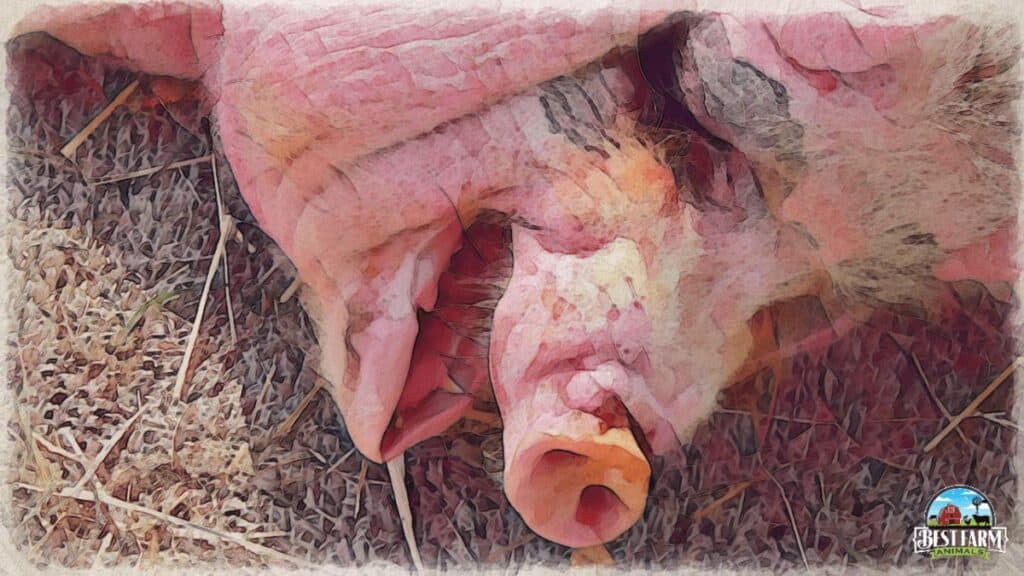
4. Pig Walking in Circles Can Signal An Infectious Condition
It may look funny if you notice your pig walking in circles, but it is a serious condition.
Pigs walk in circles due to a middle ear infection, a brain stem infection, or a bacterial infection. If they are circling you, it may be a display of extreme aggression. Depending on the age of your pig, it’s one of three main infections: Listeriosis, Vestibular syndrome, or Actinobacillus.
- The vet may inject your pig with penicillin and aminoglycosides.
- Identify what caused the infection and prevent it from spreading further. A blood smear test should help in this regard.
5. My Pig is Down and Won’t Get Up—Could Be Paralysis
The motor and sensory nerves in your pig are attacked by Teschen disease. It paralyzes your pig’s hind end and, in extreme cases, can cause total paralysis.
Strangely, despite having hindlimb paralysis, your pig can still feel pinpricks and other normal sensations. Early treatment of this illness is essential because severe cases can cause irreparable harm.
Teschen disease symptoms include losing its back legs, dragging its bottom, and back paralysis. It might appear depressed and temporarily stop eating. Pigs with Teschen disease in its early stages will have wobbly gaits. They might have trouble standing.
Steps to Take if Your Pig’s Hind Area is Paralyzed:
- Pigs need antibiotics and vaccine before symptoms arise
- Piglets need colostrum to immunize against Teschen disease
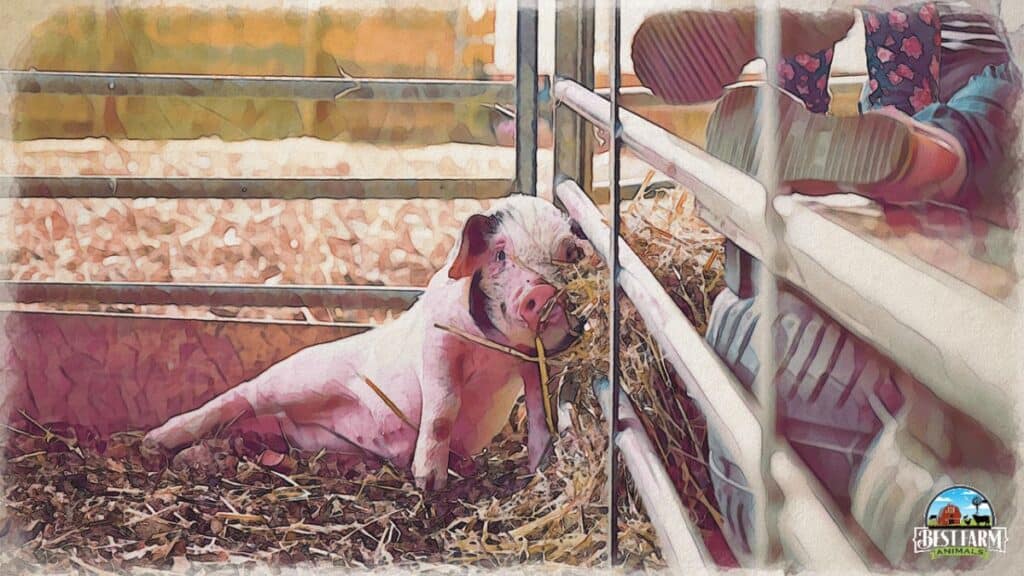
6. Sick Pig Has Lethargy, A Main Sign of Swine Influenza
A lethargic pig lies down more frequently and for longer stretches of time. Additionally, your pig may appear quite pale, particularly around their gums, ears, and nose.
Paying close attention to your pig is essential because lethargy is frequently a sign of illness, such as swine influenza (a respiratory disease in pigs). Coughing, sneezing, rapid, shallow breathing, a runny nose, a fever, and loss of appetite are symptoms of swine influenza (SIV). When treating a sick pig, use caution because swine influenza can be transmitted to humans. In addition, the herd moves through it quickly.
Steps to Take if Your Pig is Lethargic:
If you suspect Swine Influenza, take precautions to keep yourself safe. Wash your hands, avoid contact with any cuts or scrapes you have. Personally, I’d even change my clothes after helping my pig.
- Isolate all sick pigs
- Give antibiotics to all pigs with a fever or coughing for at least three days.
- Provide your pig with electrolytes
7. Pigs That Won’t Stand Up Is A Serious Sign Of Sickness
If your pig refuses to stand up when it’s time to eat, this is cause for concern. Your pig may be suffering from bacterial muscle infections brought on by one of the Clostridial diseases or joint pain from an injury. They consist of conditions like pulpy kidney, botulism, black disease, blackleg, tetanus, and malignant oedema.
Swollen muscles, lethargy or listlessness, red rashes, stiff legs, severe lameness, paralyzed tongues, and other muscle and functional problems are signs of clostridial diseases. Pigs may also experience blood-tinged diarrhea.
Steps to Take if Your Pig Doesn’t Want to Get Up
- Test your pig for Clostridial disease through your vet
- Administer Penicillin for about 3 to 4 weeks.
- Anti-inflammatory drugs to reduce the swelling of the muscles.
- Gentle walking promotes blood flow.
- Moving your pig to a pen with sand or sawdust shaving flooring can also help exercise and loosen the muscles.
8. Telling If A Pig Is Constipated Or Not
Pigs with constipation, persisting for longer than 72 hours, may experience serious health issues. You should call the vet if that happens.
The production of milk and colostrum is linked to constipation, which is more prevalent in sows. Pigs with constipation may drink more water than usual, exhibit nervousness and a humped back, and moan or grunt while going to the bathroom.
Long-term constipation can make an animal less hungry. Constipation can also be indicated by symptoms of a stomach ache and a hesitancy to stand up after lying down.
Steps to Take if Your Pig is Severely Constipated:
- Plenty of cool water
- Mix cranberry, prune, or apple juice with water
- Soften your pig’s food with warm water.
- Increase your pig’s fiber intake.
- Pumpkin can be fed to pigs for up to 2 weeks and regularly
- High-fiber cereals and laxatives (decreasing over 2 weeks)
- High-fiber fruits: Prunes, blackberries
- One teaspoon of lard (or any animal fat) can be given once or twice daily (check your state regulation as this may be illegal in pigs bred for slaughter).
- Use enemas or suppositories to help your pig have a bowel movement.
- If the constipation is not severe, a warm bath will help ease their constipation.
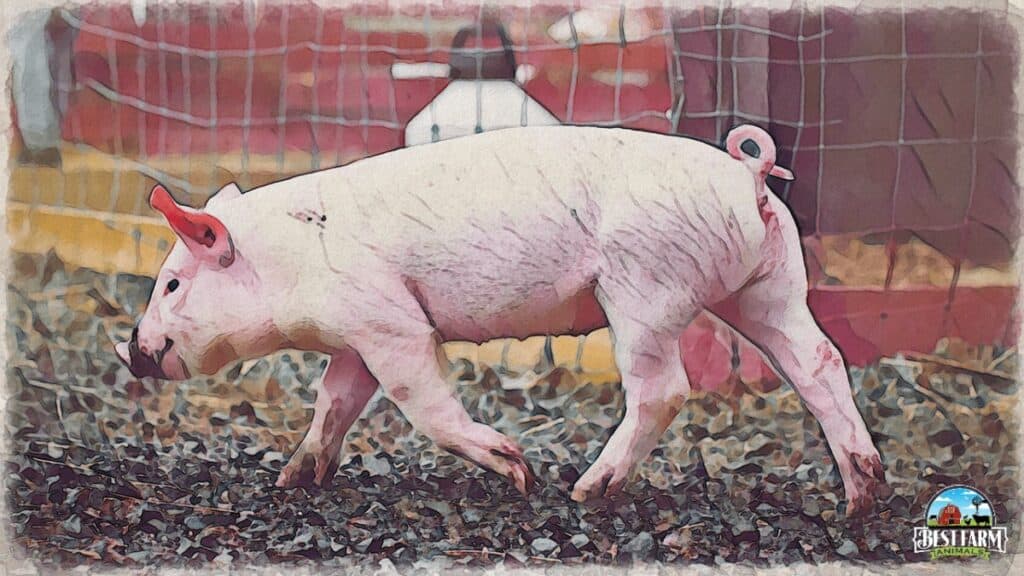
9. Pig Respiratory Issues May Cause Fever and Pig Sneezing
There are several illnesses that can cause respiratory issues in your pig, such as influenza A, mycoplasma hyopneumoniae, and porcine circovirus. Symptoms of respiratory illnesses include sneezing, a runny nose, coughing, barking, panting or rapid breathing, a fever, skin discoloration, and an effort to breathe. Your pig may seem out of breath for no reason.
Steps to Take if Your Pig Has Respiratory Issues:
- Antibiotics will need to be administered by your vet.
- Make sure the pigsty is clean.
- Give your pig warm broth.
- Encourage your pig to move around for little bits at times.
10. Dark-Colored Urine Is A Sign Of Dehydration
If your pig has dark-colored urine, it usually indicates dehydration or a urinary tract infection such as Porcine cystitis or urinary stones. Treating your pig as early as possible would be best to avoid further bacterial bloom, leading to renal failure.
A few symptoms of porcine cystitis are weight-loss, reduced activity, frequent peeing, blood-stained urine that stinks.
Reduced productivity
Frequent urination, with little amounts of urine
Blood-stained and cloudy urine
Foul-smelling urine (more than usual)
Steps to Take if Your Pig Has Dark Urine:
These steps will help alleviate the symptoms of dark-colored urine:
- Give your pig analgesics to help with the pain (Flunixin meglumine is the common choice at 5-10 mg per 10 pounds).
- Provide plenty of clean, fresh water to flush the urinary tract.
- Antimicrobials will need to be injected to remove the organisms.
- Water mixed with fruit juice will keep your pig hydrated.
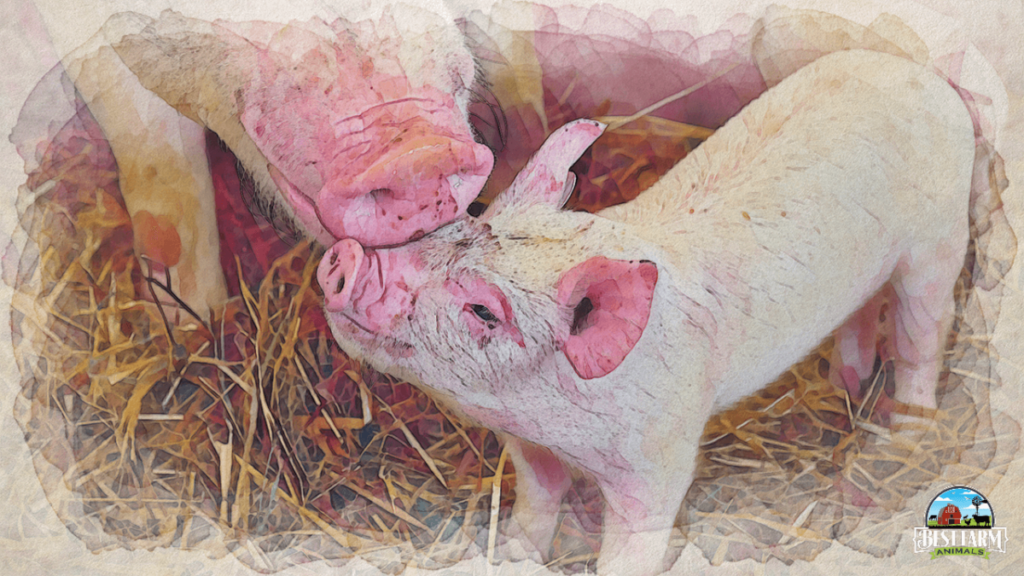
11. Fever Is A Sign Of A Very Sick Pig
If your pig’s skin appears dull with a slight reddish shade, this can indicate a fever (high body temperature). A fever can be one of your pig’s first viral or bacterial infection signs. Fevers can also be brought on by inflammation caused by allergies or the ingestion of toxins.
A pig’s baseline temperature should be between 98 – 101℉. Not all fevers are bad, as it’s the body’s way of fighting off infection. However, if the temperature goes over 104℉, you need to call the vet urgently.
Your pig may will usually get a fever if something is wrong. Other signs something is wrong includes your pig breathing rapidly, it feels warm to the touch, is acting lethargic, isn’t eating, is unstable, or is vomiting.
Your pig may seem unstable on their feet
Vomiting
Yellow-colored diarrhea
Steps to take if your pig has a fever:
These steps will help reduce the symptoms of fever:
- Your vet should administer a broad-spectrum antibiotic to treat any infection that could be causing the fever.
- Check your pig’s temperature regularly.
- Increase your pig’s fluid intake and offer them ice cubes to help cool them down. You can also mix ¼ cup of apple juice with a ¾ cup of water and freeze it in a popsicle mold before giving it to the pig to lick.
- Use a cool, wet cloth to dampen your pig’s coat. Focus on the ears and feet, which generate the most heat.
- You can wrap ice packs in towels and place them where your pig lies down, to try and cool down the area and their body.
Pig Illness and Symptoms Chart
| Disease or Illness | Acute Symptoms | First Steps to Take |
| Porcine epidemic diarrhea (PED) | Vomiting Diarrhea | Isolate pig, watch to see if it vomits after drinking water. Avoid food for the first few hours after vomiting. |
| Hemagglutinating encephalomyelitis (HEV) (most common in piglets) |
| Ensure the pig isn’t coughing and sneezing from excessive dust, pollen, or environmental causes. Move pig to a clean area if needed. Feed only water for a few hours until vomiting has ceased. |
| Gastroenteritis (TGE) |
| Isolate pig. Feed water as long as it can drink without vomiting. |
| Classical swine fever (CSF) |
| Immediately isolate sick pigs. If your pigs have CSF, they will need to be put down. Call a local vet to identify if CSF is the cause of the illness. |
| Listeriosis, vestibular syndrome, or actinobacillus |
| Depending on the age of your pig, it will signal which of these disease its most likely to be suffering from. Seek vet assistance immediately as death often comes quickly |
| Teschen Disease |
| Seek immediate help. Paralysis can cause permanent damage and become permanent. |
| Swine Influenza and other Respiratory Ailments |
| Isolate, antibiotics are usually needed unless it is from an event such as a new pigsty that’s dirty or a dust storm |
| Porcine Cystitus |
| Provide plenty of water, or sweeten with fruit juice. Administer antimicrobials. |
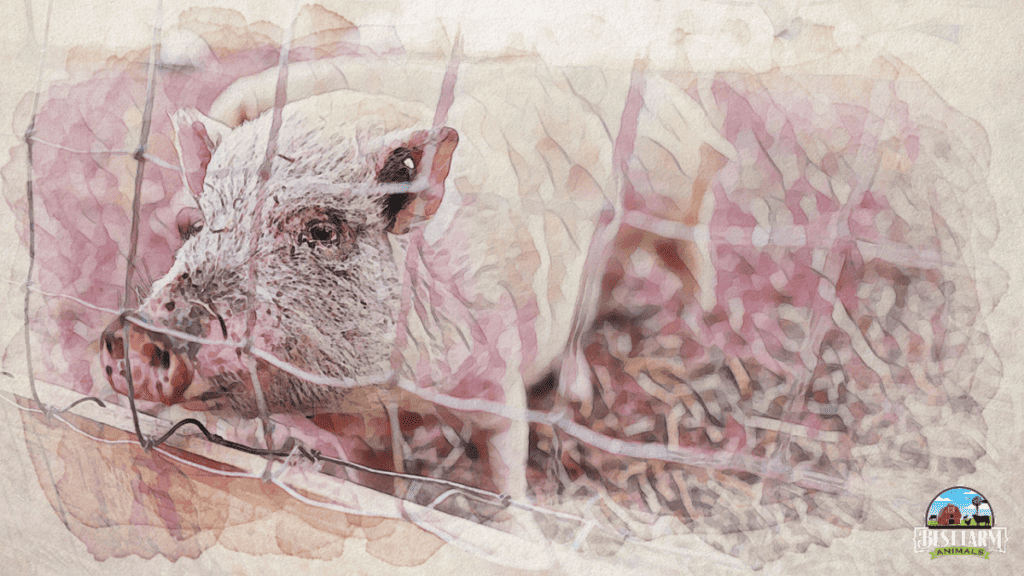
Sick Pig FAQs
Treating a sick pig quickly is essential, as the illness can spread through the rest of the herd. Ensure you familiarize yourself with the symptoms to treat your pig correctly.
What are the signs of a pig dying? If your pig is in the process of dying they will stop moving around as much and sit in a hunched position. They may even lie down on the ground and refuse to move. A dying pig may start trembling and withdraw from other pigs. Occasionally a dying pig might squeal or moan due to pain. Convulsions may also set in as muscles deoxygenated.
Can I give my pig Gatorade? You can give your pig Gatorade if they refuse to eat or drink. A popular flavor that pigs enjoy is the Gatorade Melon flavor. Gatorade is a good source of electrolytes for your pig, especially if they’ve been suffering from diarrhea or vomiting. The Gatorade will help hydrate your pig. Feed the Gatorade at room temperature.
Can you put Vicks on a pig? Using Vicks on a pig (or any other animal) is not advised. Vicks has a potent smell which can affect your pig’s sense of smell. The main ingredient in Vicks is camphor which is known to cause skin irritation in animals, including pigs. A pig might hurt themselves trying to rub the Vicks off their irritated skin.
How to treat a sick piglet? If your piglet is sick, it’s essential to keep them comfortable and encourage them to drink and eat. Piglets can dehydrate very quickly, which can lead to death. If they refuse to eat, feed the piglet softened food and water through a syringe. You can also inject vitamin B and B12 to give them additional nutrients and encourage healing.
Conclusion
Luckily, with my neighbor’s helpful information and guidance, we treated our pig successfully. The piglet is now running around happily and being his usual piggish self while he scoffs pellets, hay, and a few pumpkins.
If anything, this whole experience has taught me that you need to monitor your pigs daily and get used to their behaviors so you can successfully pick up on any issues or signs of illness. Being alert will give you the knowledge to treat them timeously and correctly and avoid critical situations.
To learn more about pigs and how long they live, you can read on pig longevity too.
My Most Used Pig Supplies
This list contains affiliate products. Affiliate products do not cost more but helps to support BestFarmAnimals and our goal to provide farm animal owners with accurate and helpful information.
Purina Pig Chow will last well (or Mazuri is popular, but I haven’t tried it), and the stainless steel non-skid bowls that will help keep the mess down.
A pig blanket to keep her warm. This one also has bright colors and helps to provide rooting without the destruction.
Pig Harness for walking and handling your pig. There are a lot to choose from, but this one is pretty easy to use. If you want one that has a separate leash, this looks like a good one.
A large crate for keeping her safe in your house at night and when you leave the house. This is essential. You’ll also want a litterbox, and I like mine with a lid for nighttime. Pine shavings are best, and you may be able to find them in larger quantities locally.
When you have accidents, Odoban will help eliminate odors. When you are potty training, these floor pads work great for keeping your house clean while training her to go in certain places.
You’ll also want an outdoor house to keep her warm when she gets outside time, an essential part of her development.
Dewormer- Ivermectin is the primary dewormer I use, although I do rotate with a non-ivermect ingredient once so that the worms don’t get immune to it.

